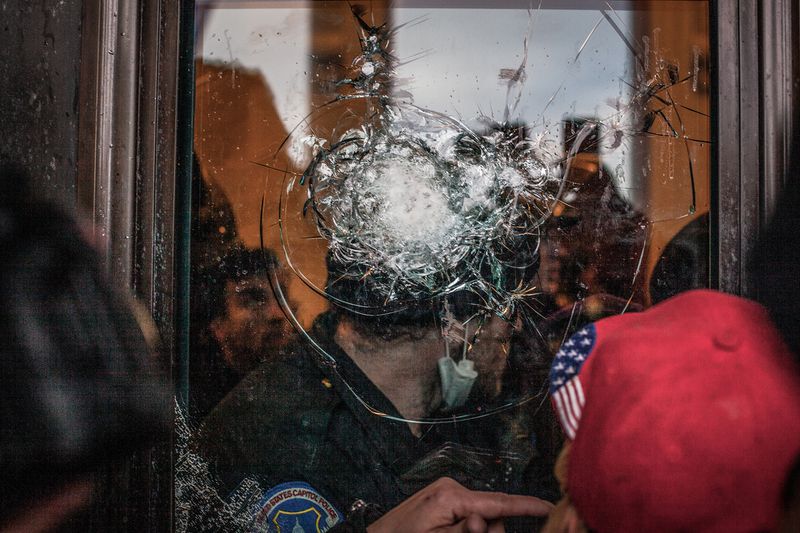
Former president Donald Trump at a Turning Point Action gathering, in Phoenix, Arizona, on July 24, 2021. | Ross D. Franklin/AP Photo
The insidious way violence is changing American politics — and shaping the 2024 election.
Stephen Richer should have been safe.
In early 2021, Richer was an Arizona Republican official who regularly attended local party events. At the time, he was the newly elected county recorder of Maricopa County. The job was a new level of prominence — he was now the most important election supervisory official in the state’s largest county — but going to Arizona Republican events was routine: the kind of thing that Richer, like any state politician, had done hundreds of times before.
But at one event, the crowd heckled and harassed him. When he tried to leave, they dragged him back in, yanking on his arms and shoulders, to berate him about the allegedly stolen 2020 election. He started to worry: Would his own people, fellow Republican Party members, seriously hurt him?

Justin Sullivan/Getty Images
Maricopa County recorder Stephen Richer speaks to reporters during a news conference at the Maricopa County Tabulation and Election Center on November 10, 2022, in Phoenix, Arizona.
There was a clear reason for the madness. Many of the Republican faithful had recently decided that Maricopa County had been the epicenter of “the steal,” Joe Biden’s theft of Arizona from Donald Trump — and the entire presidential election with it. This wasn’t true, obviously. Richer tried to tell them it wasn’t true, hoping his long track record in the state Republican party would give him some credibility.
It did not. What happened instead reveals a pattern that is quietly reshaping American politics: Across the board and around the country, data reveals that threats against public officials have risen to unprecedented numbers — to the point where 83 percent of Americans are now concerned about risks of political violence in their country. The threats are coming from across the political spectrum, but the most important ones in this regard emanate from the MAGA faithful.
Trump’s most fanatical followers have created a situation where challenging him carries not only political risks but also personal ones. Elected officials who dare defy the former president face serious threats to their well-being and to that of their families — raising the cost of taking an already difficult stand.
As a result, the threat of violence is now a part of the American political system, to the point where Republican officials are — by their own admissions — changing the way they behave because they fear it. For Richer, the price back in 2021 was high — and enough to prevent him from safely participating in his own party’s politics.
The more he tried to convince people that the 2020 results were legitimate, the more hostile the audience became — and not just at this one event. He recalls people at Republican meetings getting in his face, grabbing him, and even banging on his car windshield in the parking lot. Richer kept attending party meetings for three months, hoping that the attendees’ behavior would go back to normal.
But they didn’t. The once-friendly events were emotionally exhausting — and, worse, potentially even dangerous.
“I was a Republican activist. That’s what you do: show up to events,” Richer recalls. But eventually, “you don’t feel comfortable.”
By 2022, when Richer was presiding over the November election’s ballot tally, his office was fortified like a military base: surrounded by armed police deployed to protect him and his staff from threats. He recalls numerous staff members quitting on the spot after heated confrontations — and he was personally targeted by credible threats. When we spoke, he was about to testify in one of three federal cases against people who had vowed to kill him.
“You need to do your fucking job right because other people from other states are watching your ass,” the man allegedly said in a voicemail. “You fucking renege on this deal or give them any more troubles, your ass will never make it to your next little board meeting.”
It’s been well over two years since Richer attended the kinds of Arizona GOP grassroots events where he was once welcome. Today, the institutional Arizona Republican party is dominated by politicians who have embraced Trump’s lies about the election — people like Kari Lake, Blake Masters, and Mark Finchem. The harassment and threats from the MAGA faithful was one weapon in the extremist takeover’s arsenal, working to push voices of sanity out of key party events — breaking even determined ones like Richer.
In Arizona, the Trumpist threat of violence worked. And it worked for reasons that should worry all of us at the beginning of an election year that could decide the fate of American democracy.

Matt York/AP Photo
A woman points at Maricopa County Recorder Stephen Richer during the Maricopa County Board of Supervisors general election canvass meeting on November 28, 2022, in Phoenix.
Brave Republicans at all levels of government, from local officials like Richer to Sen. Mitt Romney (UT), have been warning us of the dangers going into 2024. They have seen the recent rise in right-wing political violence, most notably on January 6, and seen how comfortable Trump is with openly directing his supporters to hurt people.
“Violence and threats against elected leaders are suppressing the emergence of a pro-democracy faction of the GOP,” writes Rachel Kleinfeld, an expert on political violence at the Carnegie Endowment for International Peace. Absent threats, Kleinfeld argues, a move to Trump from inside the party — perhaps a more serious challenge in the presidential primary — might have had a better chance of getting off the ground.
In her paper, Kleinfeld notes a striking example of this effect at work — a comment by Kim Ward, the Trump-supporting Republican leader of the Pennsylvania state Senate, on what would happen if she spoke out against the former president.
“I’d get my house bombed tonight,” Ward said.
Our politics have gotten more violent
Bob Inglis, a South Carolina Congressman for 12 years who left office in 2011, remembers getting in some fairly bitter brawls with his Democratic rivals. In his later years as a Congress member, after making a more moderate turn, he recalled receiving some real vitriol from the base — even facing a crowd in his hometown that seemed so volatile that he refused to introduce his family on stage.
But that was the exception, not the rule.
“Now,” Inglis says, “members of Congress face that [level of hostility] routinely.”
In 2016, the Capitol Police recorded fewer than 900 threats against members of Congress. In 2017, that figure more than quadrupled, per data provided by the Capitol Police.
The numbers continued to increase in every year of the Trump presidency, peaking at 9,700 in 2021. In 2022, the first full year of Biden’s term, the numbers went down to a still-high 7,500. The 2023 data has not yet been released, but a spike in threats against legislators during the House Republican speaker fight and Israel-Hamas conflict suggests an increase over the 2022 numbers is plausible.
Members of Congress are taking these threats seriously. In September, three journalists at the Washington Post reviewed FEC filings to assess how much candidates for the House and Senate were spending on security. They found an overall increase of 500 percent between 2020 and 2022.
The death threats aren’t just directed at politicians in Washington. Data has shown extraordinary levels of threats against mayors, federal judges, election administrators, public health officials, and even school board members. It’s hard to know how large the increase is for many of these local positions because no one has been keeping records for all that long. In the past, there was simply no need.
“It’s not even accurate to say [threatening election workers] was rare prior to 2020. It was so rare as to be virtually nonexistent,” David Becker, executive director of the Center for Election Innovation & Research, told me in 2021. “This is beyond anything that we’ve ever seen.”
While this level of threat is unfamiliar in modern America, political violence is far from unprecedented in the long arc of the country’s history. We’ve seen a civil war, the assassinations of multiple presidents, and a senator beaten unconscious on the Senate floor
“American politics has always been violent. The question is how violent,” says Joanne Freeman, a historian at Yale and author of a book on violence in Congress before the Civil War.
Freeman and other scholars see rising political violence as a reflection of deeper political tensions. Research suggests it tends to be perpetrated by angry, aggressive people with poor impulse control. Systematic increases in violent threats would thus happen at moments of heightened political emotion — meaning those times when the stakes of politics seem especially high and personal.
That’s clearly the case now.
Some of the recent increase in American violence (both political and otherwise) might be attributable to the pandemic. But the spike in threats began well before Covid-19. Something else is going on — something that’s raising the temperature of American politics, making people feel more angry, afraid, and feeling like they need to take political matters into their own hands.
That “something” is Donald Trump. No figure in American politics commands Trump’s devoted following; no figure is as capable of heightening the stakes of American politics to the breaking point.

Evan Vucci/AP Photo
President Donald Trump speaks during a rally protesting the electoral college certification of Joe Biden as President in Washington on January 6, 2021.

Evan Vucci/AP Photo
People listen as then-President Donald Trump speaks during a rally on January 6, 2021, in Washington.
Trump’s hardcore base is motivated by social grievances that are known to give rise to violence. Political scientists have repeatedly found that ethnic violence is particularly likely when a privileged portion of society sees power slipping into the hands of a group that hadn’t previously held it — as has been happening in the United States for years. A backlash to social change is probably the single biggest reason behind both Trump’s political rise and the rash of white supremacist terrorism starting in the late 2010s, like the Pittsburgh synagogue shooting in 2018, the attack on an El Paso Walmart frequented by Latinos in 2019, or the 2022 massacre of supermarket shoppers in a Black area of Buffalo.
The former president’s rhetoric has often directly encouraged violence. At a 2016 rally in Iowa, Trump instructed his supporters to “knock the crap out of” disruptive protesters. “I promise you I will pay for the legal fees,” he added. During the 2020 protests over George Floyd’s murder, Trump implied that any rioters should be shot by tweeting an old white supremacist slogan: “when the looting starts, the shooting starts.”
And, at the fateful rally on January 6, 2021, he told his assembled supporters that “if you don’t fight like hell, you’re not going to have a country anymore.” That day, and ones immediately to follow, dramatize just how profoundly threats of violence have come to shape Republican politics.
How the threat of violence cemented Trump’s control over the GOP when it looked most vulnerable
On January 6, a crowd chanting “hang Mike Pence” rampaged through the Capitol’s halls. Members of Congress on both sides legitimately feared for their lives, leading many Republicans to privately support Democrats’ impeachment push afterward. Trump, they believe, needed to be held accountable for what they had been through.
But the fear of physical harm, of someone killing them or their families, held some of these Republicans back from voting to impeach him. The threat even became a tool of peer pressure — Republicans citing the danger of speaking out to keep each other in line. Sen. Romney recounted stories to this effect to the Atlantic’s McKay Coppins:
When one senator, a member of leadership, said he was leaning toward voting to convict, the others urged him to reconsider. You can’t do that, Romney recalled someone saying. Think of your personal safety, said another. Think of your children. The senator eventually decided they were right.
Romney personally refused to bow to this intimidation and voted to impeach, just as he did during Trump’s first impeachment. But not every Republican displayed this level of bravery in the face of serious threats to both their political and personal future.
Just before the House vote on impeachment, Rep. Jason Crow (D-CO) has said he heard firsthand from Republicans that fear was holding at least two of them back.
“I had a lot of conversations with my Republican colleagues last night, and a couple of them broke down in tears — saying that they are afraid for their lives if they vote for this impeachment,” he said in an MSNBC appearance.
Former Rep. Peter Meijer (R-MI) recalls one of his House colleagues privately condemning Trump’s claims of election fraud, but voting to overturn the election results on the evening of January 6 — just hours after the assault.
“My colleague feared for family members, and the danger the vote would put them in,” Meijer wrote in a Detroit News op-ed. This fear wasn’t idle: After voting to impeach Trump, Meijer himself faced so many threats that felt the need to purchase body armor.
And reporters confirmed these accounts.
“I know for a fact several members *want* to impeach but fear casting that vote could get them or their families murdered,” journalist Tim Alberta tweeted before the House impeachment vote.

Shay Horse/NurPhoto via Getty Images
Trump supporters hold a “Stop the Steal” rally in DC amid ratification of the presidential election on January 6, 2021, in Washington, DC.
While the January 6 riot failed to crown Trump president, it had a clear and undeniable secondary effect: intimidating Republicans who might otherwise have voted to impeach him. Absent these threats, it’s possible that Republicans like Romney could have mustered up additional GOP votes in the Senate to convict Trump.
If these threats could so powerfully shape the behavior of some of America’s wealthiest and most powerful legislators, how much might they affect state and local officials with far fewer resources?
The unique importance of Republican-on-Republican violence
The increase in threats of late is bipartisan. Ordinary Democrats and Republicans feel like politics have taken on an existential cast in the Trump era, and there are angry people with poor impulse control from all factions in both parties. In 2017, a left-wing extremist opened fire on Republican members of Congress practicing for the Congressional Baseball Game, nearly killing Rep. Steve Scalise (R-LA).
Since then, staunch Trump-aligned Republicans like Rep. Matt Gaetz (FL) have said they’d experienced significant levels of threat. Jewish and Muslim Democrats with differing positions on the Israel-Palestine conflict have reported significant increases in death threats during the Israel-Hamas war. All of this is consistent with data showing partisans of both sides issuing threats at higher rates than they did in the pre-Trump era.
But this does not mean the threats are evenly distributed, or that the effects are symmetrical across officials of both parties.
The simplest way to think about it is that threats on the right are more credible than threats on the left. Statistics regularly show that far-right political violence is not only more common than other forms in today’s America but also far more deadly and impactful. In recent years, far-right killers have been responsible for the largest mass murders of Jews and Latinos in American history and the only riot ever to breach the US Capitol.
Moreover, the physical realities of political life make one uniquely exposed to radicals on one’s own side. Stephen Richer wasn’t attending Democratic rallies back when Arizona Democrats hated his guts; he had no reason to. But putting himself in front of Republican crowds made him uniquely exposed, especially in places where people bring their firearms everywhere they go.

Lynsey Addario/Getty Images Reportage
Supporters of Donald Trump gather in front of the Harrisburg Capitol building to protest the 2020 election results, which declared Joe Biden as the winner on November 7, 2020, in Harrisburg, Pennsylvania.
Romney recalls feeling this kind of fear when he went to Utah after the Trump impeachment fight. Facing crowds full of Mormon Republicans who had long been his base, he received such a hostile reaction that he was beginning to fear for his life. “It only takes one really disturbed person,” he told Coppins, adding that he began paying $5,000 a day out of pocket for personal security.
The special impact of right-on-right violent threats isn’t just about means and opportunity; it’s also about motive.
Broadly speaking, Democrats have safety in numbers from the far right: Because the party in general opposes Trump and Trumpism, individual members’ anti-Trump positioning is less likely to attract ire from his supporters. By contrast, individual Republicans who dissent from the Trumpist line immediately get singled out in conservative and far-right media — attracting the sort of attention reserved for a handful of “most hated” Democrats such as Reps. Nancy Pelosi (CA) or Ilhan Omar (MN).
For all these reasons, threats of violence are likely to be uniquely effective on Republicans when issued from their own base. The threats work, more than anything else, to discipline elected Republicans — to force them to toe whatever line the Trumpists want them to walk, or else.
That said, the power of this disciplining effect will likely vary from case to case. During October’s battle to decide the next speaker of the House, supporters of the Trumpy Rep. Jim Jordan (OH) directed a large number of death threats at House Republicans who refused to vote for him. But this time, the wavering Republicans refused to cave — even citing the threats as a reason for opposing Jordan, who was ultimately forced out of the race.
But we have no reason to believe the threat of violence has lost its disciplining power entirely.
For one, the danger simply hasn’t gone away: Data on threats to local officials released in September, from Civic Pulse and Princeton’s Bridging Divides Institute, shows that the level of threat has remained constant over the past year.
“The threat against [Trump-skeptical Republicans] is real and continuing,” writes the Council on Foreign Relations’ Jacob Ware. “Trump today retains an overwhelming power to deploy vitriol and violence against his political rivals.”
For another, the Jordan speakership fight was missing several crucial features that make threats appear more serious. Unlike the 2020 election, which forced Republicans in the House and Senate to pick between siding with Trump or the Democrats, this was an internal fight between conservative Republicans. And it’s one where Trump’s personal future wasn’t directly at stake — unlike, say, this year’s election.
Threats and the 2024 election
As Trump returned to the campaign trail in 2023, he became increasingly willing to employ naked authoritarian rhetoric and physical threats.
He encouraged people to “go after” New York Attorney General Leticia James, suggested shoplifters should be shot, and intimated that former Joint Chiefs of Staff chair Mark Milley deserves to be executed. Perhaps most ominously, he vowed to “root out the communists, Marxists, fascists, and the radical left thugs that live like vermin within the confines of our country that lie and steal and cheat on elections.”
According to Kleinfeld, people around the world are substantially more likely to engage in political violence when they feel like they have permission from their political representatives to do it. It’s a major part of the reason why, in the US data she’s examined, incidents of threats and actual violence are “three to five times higher” on the political right today than on the left.
This cannot be lost on Republican officials, and their behavior in the past few years suggests it in fact isn’t. The lockstep support for Trump even after four indictments, indicates they remain disciplined by the former president’s power — both electoral and physical. The lessons of January 6 and its aftermath have been fully internalized.
And we’re now entering an election season that’s especially likely to raise the threat level.
During the last presidential election cycle, threats against public officials tended to rise at pivotal moments in the campaign calendar. Threats against local election officials peaked around the November 2020 election itself, while threats against members of Congress (of course) spiked in the days around January 6. Thankfully, none were killed during either of those periods — but not for lack of trying.

Paul Sancya/AP Photo
Armed men stand on the steps at the Michigan State Capitol after a rally in support of then-President Donald Trump in Lansing, Michigan, on January 6, 2021.
Then-Philadelphia City Commissioner Al Schmidt, a Republican responsible for election oversight, became a lightning rod in 2020 when Trump singled him out by name in a tweet as someone who was “being used big time by the Fake News Media” as a cover for election fraud.
He received a wave of threats; a deputy commissioner, Seth Bluestein, was subjected to anti-Semitic abuse. Schmidt’s wife got emails with threats such as “ALBERT RINO SCHMIDT WILL BE FATALLY SHOT” and “HEADS ON SPIKES. TREASONOUS SCHMIDTS.” The family left their home for safety reasons after the election, and Schmidt did not run for reelection in 2023 (he was recently appointed to serve as secretary of state under Pennsylvania’s Democratic governor, Josh Shapiro).
The 2024 election promises to be every bit as contentious. If anything, Trump’s ongoing legal woes make the stakes even higher — both for him and his movement. His rhetoric is already escalating, his followers at even higher alert for signs of betrayal from the “RINOs” in the “Republican establishment.”
Never before has it been more important for Republican officials to stand up for the integrity of the American electoral system. But they haven’t faced this level of threat in their political lives — in fact, no currently living elected official has.
“They say ‘it’s never been this bad before.’ Well, on the one hand, it has,” says Freeman, the Yale professor. “On the other hand … I’m talking about the lead-up to the Civil War.”
Ben Jacobs contributed reporting to this piece.
——————————————-
By: Zack Beauchamp
Title: How death threats get Republicans to fall in line behind Trump
Sourced From: www.vox.com/23899688/2024-election-republican-primary-death-threats-trump
Published Date: Tue, 02 Jan 2024 12:00:00 +0000
Read More
Did you miss our previous article…
https://politicscope.com/social-issues/take-a-mental-break-with-the-newest-vox-crossword/
I'm a writer for lifestyle publications, and when I'm not crafting stories, you'll find me cherishing moments with my family, including my lovely daughter. My heart also belongs to my pets—Sushi, Snowy, Belle, and Pepper. Besides writing, I enjoy watching movies and exploring new places through travel.

